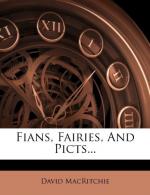he fully recognised. But it seemed equally obvious
that the “matter-of-fact” element to which
he refers could not have owed its origin to myth or
fancy. The question being fascinating, there was
therefore no alternative but to make further inquiry.
And the more it was considered, the more did his theory
proclaim its reasonableness. He suggests, for
example, that certain “fairy herds” in
Sutherlandshire were probably reindeer, that the “fairies”
who milked those reindeer were probably of the same
race as Lapps, and that not unlikely they were the
people historically known as Picts. The fact that
Picts once occupied northern Scotland formed no obstacle
to his theory. And when I learned that the reindeer
was hunted in that part of Scotland as recently as
the twelfth century, that remains of reindeer horns
are still to be found in the counties of Sutherland,
Ross, and Caithness, sometimes in the very structures
ascribed to the Picts, then I perceived this to be
a theory which, to quote his words, “hung well
together.” Further, the actual Lapps are
a small-statured race, the fairies also were so described,
and this, too, I found to be the traditional idea
regarding the Picts. Here the identification was
closer still. Then came the consideration:
The fairies lived in hollow hillocks and under the
ground: what kind of dwellings are the Picts supposed
to have occupied? The answer to this question
still further strengthened Mr. Campbell’s conjecture.
There yet exist numerous underground structures and
artificial mounds whose interior shows them to have
been dwelling-places; and these are in some places
known as “fairy halls” and in others as
“Picts’ houses.” (Illustrations of
these are shown in the present volume, and are specially
referred to in the annexed paper.)
The examination, therefore, of this interesting theory
not only helped greatly to bear out its probable correctness,
but it further began to appear that by following this
method of inquiry new lights might be thrown upon
history—perhaps upon very remote history.
It was clear that the question was not a simple one.
All tradition is obscured by the darkness of time,
and genuine fact is mixed up with ideas which belong
to the world of religion and of myth. Even in
Mr. Campbell’s own statements there were seeming
contradictions. These, however, it is not my
present purpose to discuss; since they do not vitally
affect his main contention.
The Lapp-Dwarf parallel was gone into very fully by
Professor Nilsson in his Primitive Inhabitants
of Scandinavia, written twenty years before the
“West Highland Tales.” Not that he,
either, was the originator of that theory, for it
is frequently referred to by Sir Walter Scott, who
accepted it himself.[3] “In fact,” he says,
“there seems reason to conclude that these duergar
[in English, dwarfs] were originally nothing
else than the diminutive natives of the Lappish, Lettish
and Finnish nations, who, flying before the conquering




